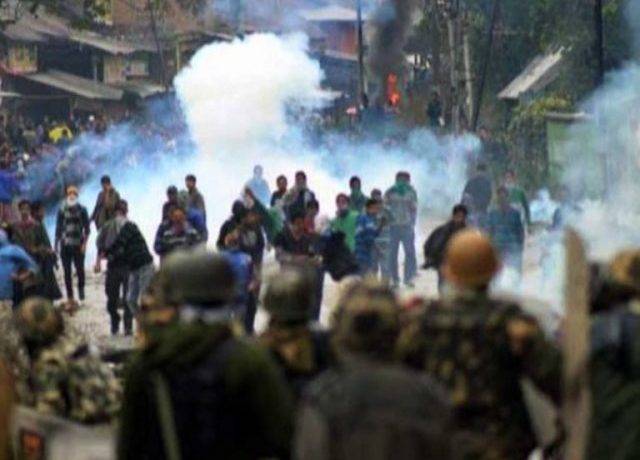6,000 Kashmiris have been buried in mass graves: The Guardian
Shares

ISLAMABAD: (APP) A bloody summer of protest in Kashmir has been met with a ruthless response from Indian security forces, who fired hundreds of thousands of metal pellets into crowds of civilians, leaving hundreds blinded.
According to an article published in The Guardian on Tuesday, the latest flare-up in the long-running war of attrition between the two countries comes on the heels of a bloody summer of protest and repression in Kashmir that has now been erased from memory by the banging of war drums in Delhi and Islamabad.
Indian forces crackdown in Kashmir
Since July, when the killing of a young Kashmiri freedom fighter Burhan Muzaffar Wani sparked a furious civilian uprising across the Kashmir valley, the Indian state has responded with singular ruthlessness, killing more than 90 people. Most shocking of all has been the breaking up of demonstrations with "non-lethal" pellet ammunition, which has blinded hundreds of Kashmiri civilians.
In four months, 17,000 adults and children have been injured, nearly 5,000 have been arrested, and an entire population spent the summer under the longest curfew in the history of curfews in Kashmir.
The world fame Guardian newspaper in its article wrote that rebellion against India's rule over Kashmir is neither new nor surprising - and the brutality of the state's response is equally familiar.
In the 1990s, India came down hard on a widespread uprising in the Kashmir valley - killing, torturing, disappearing, and imprisoning thousands. Some estimates put the number of people killed since 1989 at 70,000. Some 8,000 non-combatants are thought to have been disappeared, and 6,000 are believed to have been buried in mass graves.
Pakistan intensifies diplomatic offensive on Kashmir at UN
The article says human rights reports have identified thousands of cases of torture, including shocking techniques such as "simulated drowning, striping flesh with razor blades and piping petrol into anuses".
According to a 2012 report in the Guardian, government documents revealed that one group of security agents had "lopped off the limbs of suspects and fed prisoners with their own flesh".
In southern Kashmir, four girls, aged between 13 and 18, were shot in their faces as recently as last week.
Years later, very little has changed in the Indian state's response to the demand for self-determination from the people of Kashmir. In a matter of four to five weeks this summer, Indian troops, with a clear mandate to be unsparing, wounded over 10,000 people. One of the youngest - five-year old Zohra - was admitted to a hospital in Srinagar with lacerations to her abdomen and legs.
Fourteen-year-old Insha was in the family kitchen when a swarm of pellets pierced her face. She has lost vision in both eyes.
In southern Kashmir, the Guardian writes four girls, aged between 13 and 18, were shot in their faces last week. The prognosis for the youngest of these, 13-year-old Ifra Jan, "is not good", a doctor said. It is doubtful that these little girls posed a threat to the military force - estimated at 700,000 soldiers and police - stationed in Kashmir.
As the showers of metal pellets were unleashed upon protesters, bystanders and homebound schoolchildren, hospitals in Kashmir began to resemble scenes from the great wars of the 20th century. Rows of beds with blindfolded boys and girls on them, parents waiting anxiously, doctors and paramedics in attendance around the clock.
On occasion, police and spies also infiltrated the wards to compile profiles of the injured, in order to place them under surveillance after their release.The wounded were brought in by the dozen, like birds in the hunting season.
According to the article, all of this was incomprehensible, even to longtime observers of violence in Kashmir. One of the largest military forces on the planet could not be waging a war against seeing. Perhaps a few aberrations, a crowd-control tactic gone woefully wrong - one hoped so, but the numbers kept piling up, eye after mutilated eye popping up on the screens of phones and computers, as journalists began to publish their reports.
As none of the powerful men who run Kashmir from Delhi expressed qualms about the blinding of children, it became clear that in its hubris the Indian state had decided that snatching vision from a few hundred young people was a fair price to pay for keeping Kashmir in check.
Perhaps itself blinded by a strain of arrogance peculiar to occupying powers, it continued to pummel a subject population into submission.
The article says it is inconceivable that policy mandarins in Delhi or their advisers in Kashmir could be unaware of the destructive power of "non-lethal weapons".
Earlier this year, The Guardian says the International Network of Civil Liberties Organisations and Physicians for Human Rights published a report titled "Lethal in Disguise". "Pellet rounds", it stated, "cause an indiscriminate spray of ammunition that spreads widely and cannot be aimed ..." They, therefore, "are not only likely to be lethal at close range, but are likely to be inaccurate and indiscriminate at longer ranges, even those recommended by manufacturers for safety".
